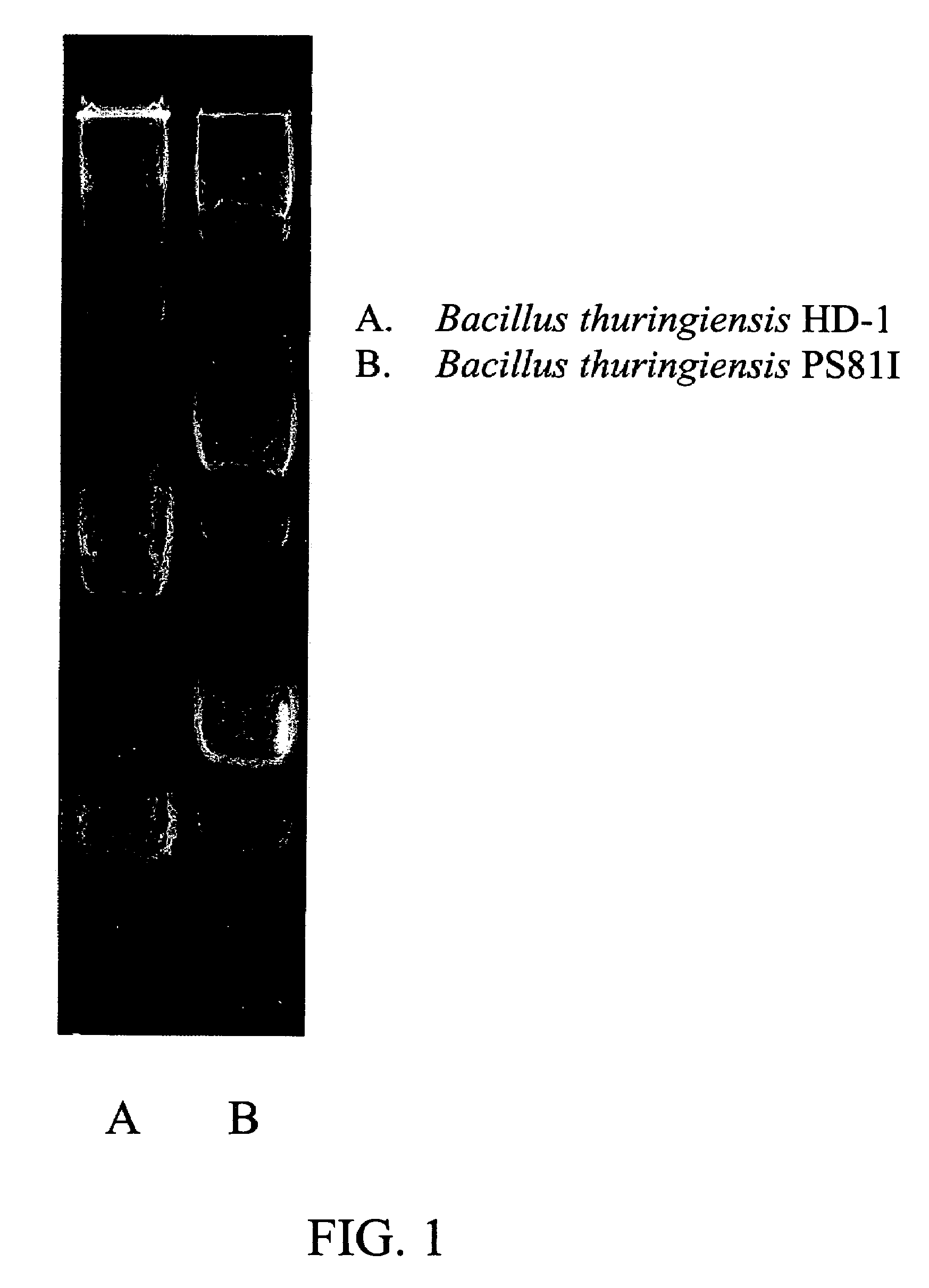Bacillus thuringiensis isolate active against lepidopteran pests, and genes encoding novel lepidopteran-active toxins
a technology of lepidopteran pests and bacteria thuringiensis, which is applied in the field of microbial pesticides, can solve the problems of toxic proteinaceous parasporal bodies or crystals
- Summary
- Abstract
- Description
- Claims
- Application Information
AI Technical Summary
Benefits of technology
Problems solved by technology
Method used
Image
Examples
example 1
Culturing B.t. PS81I
[0066]A subculture of B.t. PS81I, or mutants thereof, can be used to inoculate the following medium, a peptone, glucose, salts medium.
[0067]
Bacto Peptone7.5g / lGlucose1.0g / lKH2PO43.4g / lK2HPO44.35g / lSalt Solution5.0ml / lCaCl2 Solution5.0ml / lSalts Solution (100 ml)MgSO4•7H2O2.46gMnSO4•H2O0.04gZnSO4•7H2O0.28gFeSO4•7H2O0.40gCaCl2 Solution (100 ml)CaCl2•2H2O3.66gpH 7.2
[0068]The salts solution and CaCl2 solution are filter-sterilized and added to the autoclaved and cooked broth at the time of inoculation. Flasks are incubated at 30° C. on a rotary shaker at 200 rpm for 64 hr.
[0069]The above procedure can be readily scaled up to large fermentors by procedures well known in the art.
[0070]The B.t. spores and / or crystals, obtained in the above fermentation, can be isolated by procedures well known in the art. A frequently-used procedure is to subject the harvested fermentation broth to separation techniques, e.g., centrifugation.
example 2
Cloning of Novel Toxin Genes From Isolate PS81I and Transformation into Escherichia Coli
[0071]Total cellular DNA was prepared from B.t. cells grown to a low optical density (OD600=1.0). The cells were recovered by centrifugation and protoplasted in TES buffer (30 mM Tris-Cl, 10 mM ethylenediaminetetraacetic acid [EDTA], 50 mM NaCl, pH=8.0) containing 20% sucrose and 50 mg / ml lysozyme. The protoplasts were lysed by addition of sodium dodecyl sulfate (SDS) to a final concentration of 4%. The cellular material was precipitated overnight at 4° C. in 100 mM (final concentration) neutral potassium chloride. The supernate was extracted twice with phenol / chloroform (1:1). The DNA was precipitated with ethanol and purified by isopycnic banding on a cesium gradient.
[0072]Total cellular DNA from PS81I and B.t.k. HD-1 was digested with EcoRI and separated by electrophoresis on a 0.8% (w / v) Agarose-TAE (50 mM Tris-Cl, 20 mM NaOAc, 2.5 mM EDTA, pH=8.0) buffered gel. A Southern blot of the gel wa...
example 3
Insertion of Toxin Genes Into Plants
[0084]The novel genes coding for the novel insecticidal toxins, as disclosed herein, can be inserted into plant cells using the Ti plasmid from Agrobacter tumefaciens. Plant cells can then be caused to regenerate into plants (Zambryski, P., Joos, H., Gentello, C., Leemans, J., Van Montague, M. and Schell, J [1983] Cell 32:1033-1043). A particularly useful vector in this regard is pEND4K (Klee, H. J., Yanofsky, M. F. and Nester, E. W. [1985] Bio / Technology 3:637-642). This plasmid can replicate both in plant cells and in bacteria and has multiple cloning sites for passenger genes. The toxin gene, for example, can be inserted into the BamHI site of pEND4K, propagated in E. coli, and transformed into appropriate plant cells.
PUM
 Login to View More
Login to View More Abstract
Description
Claims
Application Information
 Login to View More
Login to View More - R&D
- Intellectual Property
- Life Sciences
- Materials
- Tech Scout
- Unparalleled Data Quality
- Higher Quality Content
- 60% Fewer Hallucinations
Browse by: Latest US Patents, China's latest patents, Technical Efficacy Thesaurus, Application Domain, Technology Topic, Popular Technical Reports.
© 2025 PatSnap. All rights reserved.Legal|Privacy policy|Modern Slavery Act Transparency Statement|Sitemap|About US| Contact US: help@patsnap.com

